- New additions
- Books recommended by training experts
- Learning books
- Corporate training books
- Instructional design books
- Learning technology books
- Virtual instructor-led training books
- Evaluation & Feedback books
- Motivation & Gamification books
- Talent management books
- Learning & business strategy books
- Learning and Development Culture books
- Interesting books that don’t fit into a category
I might be biased, but being part of the learning and development community is not only fascinating but rewarding. As a multidisciplinary field that spans the entire employee lifecycle (from recruitment to retirement), it often feels like you’re wearing more hats than you even own.
This is the precise reason it remains such a compelling subject. But it’s also the reason that to be the best trainer/ training manager/ chief learning officer, you have to keep your learning and development top of mind too.
This is why my team and I put together this list of fifty-five books. We hope that you’ll find at least one (or maybe a few more than that) that aren’t in your training bookshelf already. Use them to get better at this thing you care about so much.
The books are organized by category:
- New additions (7)
- Books recommended by training experts (4)
- Learning books (4)
- Corporate training books (3)
- Instructional design books (6)
- Learning technology books (2)
- Virtual instructor-led training books (3)
- Evaluation & Feedback books (4)
- Motivation & Gamification books (5)
- Talent management books (3)
- Learning & business strategy books (4)
- Learning and Development Culture books (5)
- Interesting books that don’t fit into a category (5)
Be sure to bookmark this page so you can return to it any time you’re stumped for answers or looking for something new to read.
If you’d like to recommend your favorite book or one that changed the way you plan your training, we encourage you to leave it in a comment below. After all, what is modern learning without collaboration?
New additions
In this newly added section, we’ve put some more books that you’ll find inspiring. The books presented below cover a wide range of topics: from how to transform the ways managers uncover and put employees’ hidden talents to good use, to applying neuroscience to training.
However, they all have one thing in common: their authors aspire to bring a fresh approach to organizational change.
 The Connector Manager: Why Some Leaders Build Exceptional Talent – and Others Don’t by Jaime Roca and Sari Wilde
The Connector Manager: Why Some Leaders Build Exceptional Talent – and Others Don’t by Jaime Roca and Sari Wilde
It’s time to learn about the different “types” of managers. Who performs better?
Backed by a global study of 9,000 people (by analysts at the Gartner firm), the authors identify managers who act as “teacher managers”, “cheerleader managers”, “always-on managers”, and “connector managers”. The last category has the most wanted ability: to build successful cross-functional teams. That’s why the authors put “connector managers” under their microscope.
This upcoming book is a must-have for those who want to improve internal communication and learn how to be “connector managers”. It’s ideal for those who aspire to build bridges across functions and departments.
Find it here.
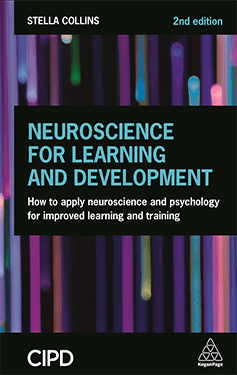 Neuroscience for Learning and Development: How to Apply Neuroscience and Psychology for Improved Learning and Training by Stella Collins
Neuroscience for Learning and Development: How to Apply Neuroscience and Psychology for Improved Learning and Training by Stella Collins
This book is a practical guide that applies neuroscience to the world of learning and development. It’s that simple.
So, if you’re looking to advance your career as an L&D professional, Collins takes the lead. She illustrates scientific and psychological insights, deepening your understanding of learning and development.
A much-needed book for every learning professional who aspires to distill innovative training and learning within an organization.
Get it here.
 Hidden Talents: Practical Tools and Inspirational Stories to Unleash Higher Levels of Leadership Performance by Maryanne DiMarzo, Amy Acker, and Rodica Ceslov
Hidden Talents: Practical Tools and Inspirational Stories to Unleash Higher Levels of Leadership Performance by Maryanne DiMarzo, Amy Acker, and Rodica Ceslov
As children, we’re brimming with imagination. But when we enter adult life, we’re pushed to narrow down our competencies. And going down the path of our hidden talents isn’t easy.
This upcoming book shares insightful knowledge regarding methods you can use to unlock employees’ hidden talents.
By depicting stories from their long-standing consulting experience, the authors convince you that there’s a glimmer of light at the end of the tunnel.
Readers have found it “thought provoking” and “inspiring”.
An easy-to-read book that can help you boost employees’ performance and cultivate much needed leadership skills.
Get it here.
 Creating Significant Learning Experiences: An Integrated Approach to Designing College Courses by L. Dee Fink
Creating Significant Learning Experiences: An Integrated Approach to Designing College Courses by L. Dee Fink
Recommended by Anna Sabramowicz, L&D expert, Founder of Scenario Design Secrets.
Little introduction is needed for L. Dee Fink, a leading figure in instructional design with over thirty years of experience. Here, you can see the author interviewed by Anna Sabramowicz, sharing insightful knowledge and tips regarding his unique design approach.
His book is a must-have for anyone who wants to design a relevant learning experience. And, with lifelong learning gaining ground, it can certainly be applied outside academia.
You can find it here.
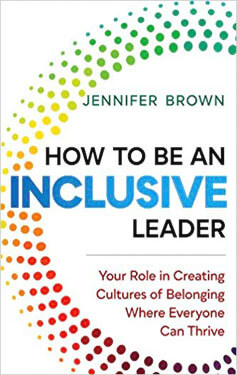 How to Be an Inclusive Leader: Your Role in Creating Cultures of Belonging Where Everyone Can Thrive by Jennifer Brown
How to Be an Inclusive Leader: Your Role in Creating Cultures of Belonging Where Everyone Can Thrive by Jennifer Brown
When you think of inclusive and diverse workplaces, what crosses your mind first? Welcome parties? Flexible maternity and paternity leave policies? Effective onboarding?
Of course, all of the above are practices that secure inclusion and diversity. But are they enough?
Brown’s book is an important contribution to the long-standing workplace debate. Her book gives you a set of four developmental stages to radically change your workplace culture.
A guidebook everyone should read; from the CEO to the last hire.
Get it here.
 Agile Transformation: Structures, Processes and Mindsets for the Digital Age by Neil Perkin
Agile Transformation: Structures, Processes and Mindsets for the Digital Age by Neil Perkin
In a rapidly changing and constantly evolving world of work, organizations need to adapt faster than light. And becoming agile represents one of the toughest challenges in a contemporary business organization.
Neil Perkin’s book is all about helping you to become an agent of change in your company.
Its most valuable contribution is that it offers tips and practical advice that can be adopted across departments and functions.
In the age of digital disruption, there is no time like the present.
Are you ready?
You can find it here.
 Bet on Talent: How to Create a Remarkable Culture That Wins the Hearts of Customers by Dee Ann Turner (author) and Patrick Lencioni (foreword)
Bet on Talent: How to Create a Remarkable Culture That Wins the Hearts of Customers by Dee Ann Turner (author) and Patrick Lencioni (foreword)
How can you attract and retain the best talent? How can you build a compelling organizational culture? And how can you turn your employees into brand ambassadors?
Turner has a long-standing career in the restaurant business. And, according to her, if you had to choose one business element to invest in, it should definitely be your human capital.
Turner’s upcoming book shares insightful knowledge and good organizational practices, helping you realize that keeping your internal clients happy equals the creation of appealing customer experiences.
Get it here.
Books recommended by training experts
As we were putting this list together, we reached out to a few instructional designers and chief learning officers and asked them one question, “Would you recommend one book that every learning professional should absolutely read?”
Here, you’ll find a list of four books approved and recommended by five of your peers.
The Learning and Development Book by Tricia Emerson and Mary Stewart
 Recommended by Suzanne Rasmussen, Instructional Designer, Manufacturing Operations at Tesla
Recommended by Suzanne Rasmussen, Instructional Designer, Manufacturing Operations at Tesla
This is the book you’ll want to keep on your desk and refer to when you’ve run out of juice or need a helping hand.
Tricia Emerson and Mary Stewart have collated their decades of experience into two-hundred pages and twenty-seven bite-sized chapters that cover four fundamentals of training: the basics, the medium (i.e., “Powerpoint is not training”), engagement and performance.
Other reviewers have called it, “a must”, “not the same old training book”, and “a tiny book with a big impact”.
Buy it, and you won’t be disappointed.
Peak: Secrets from the new science of expertise by Anders Ericsson and Robert Pool
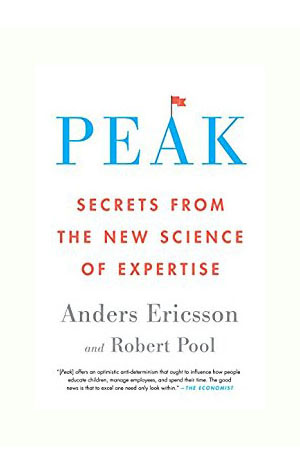
Recommended by Kiko Doran, Instructional Designer
If we were to summarize training into a sound bite, it would be close to something like, “It’s about mastery, stupid”.
Anders Ericsson has spent his career studying experts in a variety of fields. From chess champions, star athletes to entrepreneurs and brain surgeons, Ericsson has searched to find the common themes that bind them together.
In this book, he reveals all he has learned. His premise is relatively simple: “deliberate practice makes perfect”. Ericsson goes on to explain, step-by-step, how anyone can become an expert.
Seth Godin has called it a “… breakthrough, a lyrical, powerful, science-based narrative that actually shows us how to get better (much better) at the things we care about”.
And ordinary Amazon reviewers have said, “This book is remarkably straightforward and pragmatic. And it is based on more than forty years of research into dozens of different types of performance”, “a life-changing book”, and “the most important book I have ever read”.
Add this one to your library, pronto.
e-Learning and the Science of Instruction: Proven Guidelines for Consumers and Designers of Multimedia Learning by Richard E. Mayer, Ruth C. Clark
 Recommended by Adam Hain, Instructional Designer at Apple
Recommended by Adam Hain, Instructional Designer at Apple
& Irene T. Boland, Chief Learning Officer at Learning Development Institute
Yes, you read that right. Not one, but two experts recommended this book. Irene Boland explained her choice by saying that, “Learning design and development should have its roots in science”.
She’s right. Now it’s in the third edition, e-Learning and the Science of Instruction is a manual for designing effective online courses. Richard Mayer and Ruth Clark use evidence-based findings to show how (and why) it’s so important to ensure that the technology you use meets the psychological learning needs of your learners.
As eLearning continues to become more and more ubiquitous, instructional designers and anyone designing online courses in the corporate world needs to read this book. Includes best practices for how to use visuals, audio, and text in your content; design examples and exercises; and an evaluation of simulations and games that are relevant to learning goals.
It’s not called “the bible” of instructional designers for nothing.
Get it here.
A Systematic Guide To Game-based Learning In Organizational Teams: Transform Performance Through Experiential Learning, Social Learning and Team Dynamics by Ken Thompson
 Recommended by Michael Sutton, Ph.D., Chief Game-Based-Learning Officer at Funification
Recommended by Michael Sutton, Ph.D., Chief Game-Based-Learning Officer at Funification
This book is also considered a “bible” of sorts. It offers clear and practical guidance as well as detailed case studies to help you develop effective social game-based learning solutions. Michael Sutton says, “The Appendices alone are worth the price of the text”.
Indeed, you’ll get valuable resources like principles of team-based learning design, as well as different models for building business simulations.
Thompson has done a tremendous service by penning this book. It offers a step-by-step roadmap for those wanting to try incorporating games into their training. But well-versed practitioners will also find particularly useful as a reference or even as an idea sparker.
You can get it here.
Learning books
Which comes first? Learning or teaching? Teaching or learning? Thankfully, this is nothing like the classic chicken and egg problem. Learning always comes first. Before you settle down to training your employees, you first have to know how adults learn. The books in this category will help you with that.
The Adult Learner: The definitive classic in adult education and human resource development
by Malcolm S. Knowles, Elwood F. Holton III, and Richard A. Swanson

Known as the Father of Andragogy (that’s the scientific term for adult learning), Malcolm Knowles’ The Adult Learner is an indispensable, if not easy, read.
Any instructional designer or corporate trainer worth their salt should have this book on their bookshelf. Because you might read it from cover to cover just once, but you’ll also dip into it, time and time again, to refresh your memory.
First published in 1973, the 8th edition now includes thoughts on information technology and how new research in neuroscience applies to adult learning.
Reviewers have called it “very informative”, a “great introduction”, and “The standard in HRD adult learning”.
Get it here.
Adult Learning: Linking Theory and Practice by Sharan B. Merriam and Laura L. Bierema
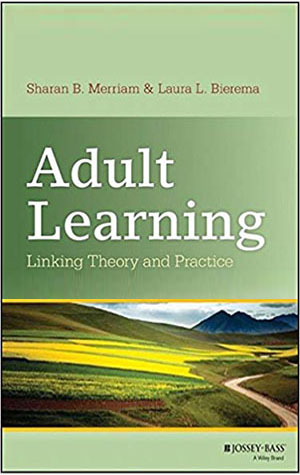
Warning: This is a textbook. One that you’ll find on most required reading lists. But it makes it on those lists for a reason.
The crisply written Adult Learning: Linking Theory and Practice covers all the fundamentals. From traditional learning theories and motivation learning to how the digital age has changed adult learning.
Victoria Marsick, a professor of adult and organizational learning at Teacher’s College of Columbia University calls it “one-stop shopping for foundational insights into how adults learn”.
Can’t get better than that. You’ll find it here.
How We Learn: The Surprising Truth About When, Where, and Why It Happens by Benedict Carey

Published in 2015, How We Learn is a compelling tome on the latest research in learning theory and cognitive psychology.
Written in story form, any educator, trainer, or learner, will find it easy to understand. Carey begins with the claim that most of our instincts about learning are misplaced, incomplete, or flat-out wrong. Yikes!
So begins a rich history of the science of learning and development packed with counter-intuitive ideas and flipping everything you thought you knew about learning on its head making it a must-read for anyone connected to learning or education. (i.e., everyone!)
Other readers have called it “a revelation”, “practical, engaging, fun, and interesting”, and “a welcome rejoinder to the faddish notion that learning is all about the hours put in”.
Put it on your wishlist now.
Make It Stick: The Science of Successful Learning by Peter C. Brown, Henry L. Roediger III, and Mark A. McDaniel

Although written for academic settings, the ideas discussed in this book can absolutely apply to the corporate world of training and development. Primarily, if your organization’s learners aren’t using their training in their work.
In Make It Stick novelist Peter Brown spins a compelling narrative with the help of cognitive scientists Henry Roediger and Mark McDaniel to, well, show you how knowledge sticks.
As unputdownable as a psychological thriller, but far more useful Make It Stick explains the human brain, how we learn and gives practical advice on how to put these evidence-backed ideas into practice.
Readers have said, “it’s packed with big ideas”, “found myself feeling empowered and excited to learn every time I picked up this book while reading it”, and “Far and away the best book on study, learning and teaching techniques on the market today”.
Get excited about learning again by finding Make It Stick here.
Corporate training books
Now that we’ve covered the learning part let’s get to teaching. Or training, in our case. These are books that will feel too far if you put them in your library. Instead, they belong in a prime position on your desk.
Telling Ain’t Training: Updated, Expanded, Enhanced by Harold D. Stolovitch and Erica J. Keeps

Telling Ain’t Training is the go-to guide to improving your training and keeping it learner-focused. With eighty years of combined experience, Stolovitch and Keeps don’t only tell you the “why” but the “how to”.
Highly engaging and, dare I say it, fun to read, Telling Ain’t Training will change the way you approach planning your next training program. In fact, read this on a Monday night, and you’ll probably be adding exercises in one of your courses by Tuesday morning.
Readers have called it “an eye-opener”, “a masterpiece”, and “my guide for years to come”.
Sounds amazing, right? Get it here.
The Online Teaching Survival Guide: Simple and Practical Pedagogical Tips by Judith V. Boettcher and Rita-Marie Conrad

If you’re transitioning from classroom training to online training, you don’t just want this book, you need this book.
While written primarily for teachers in academic settings, anyone just starting out in training and development will still find this guide incredibly useful.
Instead of organizing the book by topic, Boettcher and Conrad organized the book by where your learners are in a course. Whether you want to take a strictly online approach or a blended learning approach, The Online Teaching Survival Guide is packed with tips to inspire better training and ultimately, better learning.
Readers have called it “an online teaching bible”, “a great usable book for professional development” and “a classic”.
Find it here.
The Art and Science of Training by Elaine Biech

If you’ve never come across one of Elaine Biech’s books, you’ve been missing out. Because Elaine is the Stephen King of the training industry. She has written and edited fifty books in her thirty plus years in training and consulting private organizations, government, and nonprofits.
In The Art and Science of Training, Elaine jumps straight into the challenges that trainers face through the lens of science (how we learn) and art (making training creative and engaging).
Each chapter is titled after a question you have probably asked yourself. For example, Chapter 9, “How can you guarantee transfer of learning to the workplace?” is as practical as it gets.
Anyone struggling with proving to the C-suite that your role in the organization is fundamental and useful should flip to Chapter 11 “Why bother with evaluation and assessment?” first.
Get it here.
Instructional design books
Instructional design is a massive subject in its own right. These six books are some of the most popular ones out there. Read at your own risk because you’ll want to put everything you learn into practice immediately.
Design for How People Learn by Julie Dirksen

In Design for How People Learn, Dirksen has accomplished quite a feat. She has written arguably the most fun book on instructional design.
Yet, it’s still a comprehensive and super practical account of all you need to get started designing courses for adult learners in a corporate setting. The main takeaway is that there are different ways to create courses, depending on the goal, e.g., design for knowledge, design for skills, design for motivation and habits.
And, it’s filled with quotes you’ll want to jot down on a post-it and stick to your screen.
Readers have said it’s “spot on”, “one of the most concise, readable books on instructional design that I’ve ever read”, and “on my third re-reading of the book, keep finding new and useful information”.
Get it here.
Essentials of Online Course Design: A Standards-Based Guide by Marjorie Vai and Kristen Sosulski

If you’re less of a cook and more of a baker ( i.e., need to follow instructions to the T) you will appreciate this book by Vai and Sosulski. It’s packed with guidelines, best practices, and checklists for you to design a course without always wondering if you’re doing it right.
Pro-tip: Chapter Four aka Visual Design Basics is worth the price of admission alone.
Readers have called it, “a truly essential read”, “a great investment”, and “compact yet complete”.
Complete your training library by getting it from here.
Instructional Design that Soars: Shaping What You Know Into Classes That Inspire by Guila Muir
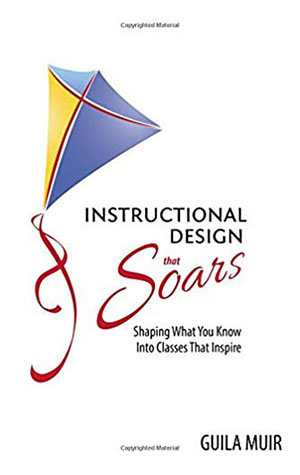
Guila Muir’s aim seems simple: to turn subject matter experts into unforgettable trainers. But we all know this is easier said than done.
In Instructional Design that Soars though, Muir’s down-to-earth tone and clear approach make it more than likely that you’ll be inspired to give it a go. Using a “kite” as a metaphor, she breaks down course design into easy and doable chunks.
Readers have said, “[it’s] a straightforward approach”, ”a great book for a new and busy trainer” and “has improved my workshops and participants satisfaction, engagement, and retention”.
Find it here.
Brilliance by Design: Creating Learning Experiences That Connect, Inspire, and Engage by Vicki Halsey

It’s standard in the day-to-day of learning and development to lose your energy and often your focus. This book will remind you that your profession is anything but unimportant. You are helping people grow – and that is a noble, worthy pursuit.
In Brilliance by Design, Dr. Vicki Halsey has written one of the most practical and disruptive books on the market. Her central thesis is that content doesn’t matter as much as the delivery. Knowns as the 70/30 rule, where you should be spending 70% of your time on how you teach and only 30% of your time on what you’re teaching.
How do you do that? With Halsey’s ENGAGE model.
Reviewers have called it, “unmatched in the arena of adult learning”, “brilliant” and “a recipe for amazing training”.
Improve your training by picking up a copy from here.
Training and Development: Communicating for Success by Steven A. Beebe, Timothy P. Mottet, and K. David Roach
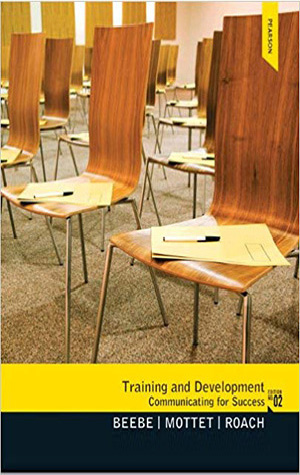
Put you ADDIEs down. It’s not the only way to train. According to this academic-favorite textbook, there’s another way.
In Training and Development: Communicating for Success, Steven Beebe, Timothy Mottet and K. David Roach take a needs-centered approach to training. With clear and engaging writing, they set out a step-by-step guide to planning, developing and implementing training programs with the learner at the core. Ideal for students and future trainers.
Reviewers have said “I’ll be referring to this book for years to come”, ”A training and development manual for life”, and “incredibly useful”.
Find it here.
Visual Design Solutions: Principles and Creative Inspiration for Learning Professionals by Connie Malamed
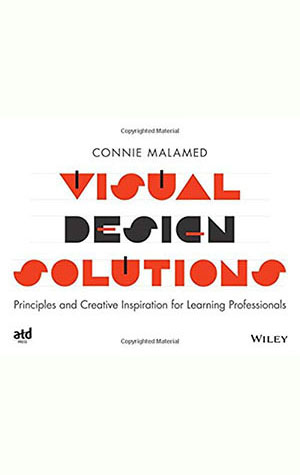
Connie Malamed aka The eLearning coach has been called “the trainer’s trainer”. This high praise is well-deserved as she offers so much to the eLearning community through her blog, her podcast, her workshops and even Twitter.
But it’s her book Visual Design Solutions where she flexes her eLearning chops. Most online courses are visual. And sure, you could haphazardly put together a course, cross your fingers and hope for the best.
Or you should keep this book close to you. Malamed expertly shares the basics (and not so basic) principles of visual design. And then links these principles to their impact on the learning process. There are tons of visual examples so you can understand what she means about the importance of whitespace, hierarchies, and typography.
Other readers have said, “[it’s] an easy to use, go-to reference”, ”I was able to make immediate connections between the ideas in the book and my projects”, and “easy to apply lessons, concepts, and examples”.
Get it here.
Learning technology books
Twenty-nine percent of training hours are delivered by computer-based technology. Now, I’m not psychic, but this means that you are currently or will be using learning software soon. These books will make that process so much smoother.
Learning Technologies in the Workplace: How to Successfully Implement Learning Technologies in Organizations by Donald H. Taylor
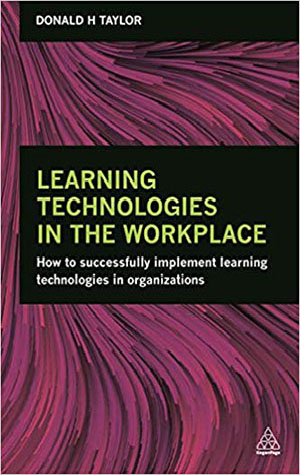
In Learning Technologies in the Workplace: How to Successfully Implement Learning Technologies in Organizations, Donald Taylor does exactly that. He answers the often ignored question, “How can I integrate tech learning tools into my organization successfully?”
Drawing on the experiences of other learning professionals, Taylor provides real-world examples to show the best practices in implementing learning technology. Spoiler alert: It’s not the tech that matters as much as the people.
Readers have said, “This book could save you time, money and a lot of embarrassment”, “It’s readable, insightful and useful” and “The Learning Technologies book we have all been waiting for”.
Save yourself the embarrassment and get it here.
LMS Success: A Step-by-Step Guide to Learning Management System Administration by Katrina Baker

One thing you learn when you’re part of a team that builds learning management systems (LMS) is that too often, organizations choose an LMS only to find out much later that it doesn’t quite suit their needs. The result? Another long search for a new LMS and extra costs.
Katrina Baker’s LMS Success: A Step-by-Step Guide to Learning Management System Administration doesn’t only hand you the right questions to ask as you choose your learning platform (the tech side) but also provides excellent advice on administration (the people side). Like, how to assemble and manage a system administrator team, and introduce the system to employees and leadership, and tons more.
Usually, you get this level of knowledge only with the benefit of hindsight.
Other readers have called it, “an amazing resource and guide”, “informative and amusing”, “fantastic”.
Buy this book before you choose an LMS.
Virtual instructor-led training books
Like democracy, blended learning is the best thing we currently have. But it’s easy to avoid live, instructor-led training when you’ve had poor experiences. No fear! These four books cover everything you’ve been afraid to ask about delivering engaging and effective live online learning.
Interact and Engage!: 50+ Activities for Virtual Training, Meetings, and Webinars by Kassy Laborie and Tom Stone

“Give a man a fish, and you feed him for a day. Teach him how to fish, and you feed him for a lifetime”. This is why Laborie and Stone’s book is so important. Not only do you get fifty plus tried-and-tested activities to use in your webinars, but you also get tips on how to use these same activities as inspiration to create your own.
What I love about this book is that the chapters are organized in the same way a webinar is arranged, i.e., the welcome, breaking the ice, the closer. This makes it simple to dip into the book when you need some help with specific sections of your webinar.
Other readers have called it “an oasis of engagement ideas and tools”, “a must-have reference guide for new virtual trainers”, and “like a cookbook for the online trainer”.
Find it here.
Creating a Sense of Presence in Online Teaching by Rosemary M. Lehman and Simone C.O. Conceição

The world of work is changing. And as someone in L&D, you might be responsible for training remote workers as well as partners and customers that are in other parts of the world.
Enter Rosemary Lehman and Simone Conceição. In this book, you’ll get smart recommendations about how to “be there” for distance learners. You’ll also learn why the concept of presence is such a valuable and useful tool for an online trainer.
Plus, it’s written from the perspective of a learner and a trainer, making this book a definitely-should-have. Especially if you’ll never meet your learners in person.
Get it for your training kit here.
Virtual Training Tools and Templates An Action Guide to Live Online Learning by Cindy Huggett
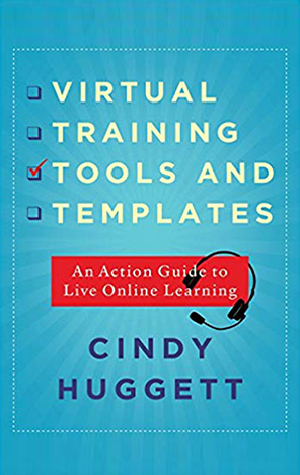
Another practical book that will hand you everything you need to deliver live online learning that works is Virtual Training Tools and Templates: An Action Guide to Live Online Learning. Cindy Huggett is highly regarded among the virtual training circles because of her hands-on approach.
And this book doesn’t disappoint. Huggett walks you through the entire process of virtual training from choosing the right technology and designing content to working with producers and preparing your learners.
Readers have called it, “the big kahuna [of virtual training]” and “my go-to resource”.
Find it here.
Evaluation & Feedback books
How do you evaluate your learners? How do you evaluate your training? If you don’t have the answers to those questions or aren’t confident about your methods, look no further. The following books explain how to measure your training and how to talk to your learners about their training.
Kirkpatrick’s Four Levels of Training Evaluation by James D. Kirkpatrick and Wendy Kayser Kirkpatrick

The name Kirkpatrick should be familiar to any professional in the L&D world. It’s the name attached to only the most well-known and widely-used training evaluation model in the world.
The Four Levels of Training Evaluation, first pioneered by Don Kirkpatrick in 1993, includes four steps of evaluation, those are reaction, learning, behavior, and results.
Now his son James has picked up the gauntlet and together with his wife Wendy Kirkpatrick have updated the model.
In this book, the husband and wife team introduce the New World Kirkpatrick Model and ensure you’re using the model to its full potential. They also share new insights, principles, and techniques that give you the tools to better train your people, including evaluating beyond the digital classroom.
Other readers have called it, “simply outstanding”, “An incredible work that benefits anyone involved with training and development”, and “the book I come back to over and over again every time I’m going to begin a new learning project”.
Get it here.
The Feedback Imperative: How to Give Everyday Feedback to Speed Up Your Team’s Success by Anna Carroll

The way we work is changing. And the people doing the work is changing too. By 2020, estimates suggest that millennials and post-millennials (aka Gen Z) will make up the majority of the world’s workforce. And surveys have found that these folks thrive on feedback.
Enter The Feedback Imperative. In this timely and urgent book, executive coach and consultant Anna Carroll makes a strong case for its importance for business. She also shares tools and tips on how to give that feedback.
Pro-tip: Her “Seven Steps to Everyday Feedback” will release any anxiety you have about offering critique to employees and peers.
Readers have said it’s “a winner”, “will transform the way you think about feedback”, and “Fresh and insightful”.
Get it here.
Fixing Feedback by Georgia Murch
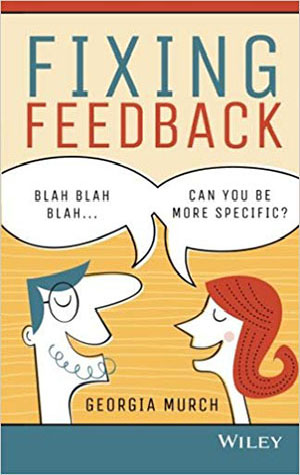
Our feedback systems are broken. Yearly performance reviews aren’t working, and one look at any comment thread on the Internet could make the most thick-skinned person flinch.
“You can’t do a remarkable job without having remarkable conversations”, says Georgia Murch. And that’s what she sets out to do in this delightful and practical book — help us have remarkable conversations. To do that, Murch shares all she has learned about communication skills during her twenty-year career.
After reading it, you’ll:
– know what gets in the way of becoming a remarkable communicator
– have a better understanding of the impact you have when communicating
– have the right techniques to give and receive feedback well
– have the tools to create a culture of feedback
Readers have called it a “great handbook for dealing with the tough conversations”, “ a great tool for aspiring and veteran leaders” and “totally a must read!”.
Fix your feedback by getting her book here.
The 5 Languages of Appreciation in the Workplace: Empowering Organizations by Encouraging People by Gary Chapman and Paul White

This books will complement your knowledge of feedback, boost your relationships with your peers and understand the people you work with.
Best-selling author of “The Five Love Languages” Gary Chapman returns to the relationship arena but this time applies his expertise to the workplace.
The result is The 5 Languages of Appreciation, a sharp text that explains the different ways people show and understand that they are valued. Armed with this knowledge, you’ll most likely be able to provide feedback in such a way that it will motivate your learners.
Other reviewers have said it’s “an eye-opener”, “powerful and simple”, and “will improve your working relationships and make people feel valued”.
Get it here.
Motivation & Gamification books
No matter the type of course you’re developing, mandatory or optional, product training or sexual harassment training, you’re going to need to motivate your learners to complete it. And your learners are almost always going to be human. (No one has tried training a dog using an LMS yet, have they?)
The following books will give you the foundation you need to understand human motivation and how to leverage that by using gamification in your course design.
The Gamification of Learning and Instruction: Game-based Methods and Strategies for Training and Education by Karl M. Kapp

If all you need to do is understand gamification and talk intelligently to designers about it, then look no further than this primer from learning expert Karl Kapp.
You’ll step away with a solid grasp of game mechanics, design principles, and strategies to incorporate into your training programs.
It’s packed with useful examples, and the three chapters by contributing writers who are experts in their field are enlightening. The one by Koreen (Olbrish) Pagano on reality games in corporate training is particularly interesting.
Others have said it’s “on target”, “a great inspiration for learning professionals”, and “the current gold standard of […] gamification”.
Get it here.
Actionable Gamification – Beyond Points, Badges, and Leaderboards by Yu-Kai Chou

Yu-Kai Chou is one of the most important thought-leaders in gamification today. And his book covers everything you’ve ever wanted to know about gamification but didn’t even know to ask.
Beginners might find the information too dense but gaming practitioners with a few years experience will find considerable value in its pages.
It provides a distinctive framework (Chou calls it Octalysis) to understand the psychology behind gamification as well as how to use game mechanics in almost anything (products, training, experiences). Every chapter ends with exercises to practice the concepts he’s presented, so it’s highly actionable too.
Other readers have called it, “a seminal text”, “a cornerstone” and “the best book in the genre”.
You can find it here.
Play to Learn: Everything You Need to Know About Designing Effective Learning Games by Sharon Boller and Karl M. Kapp

Learning experts Sharon Boller and Karl Kapp walk you through the steps of game-based learning in this super practical book.
Filled with plentiful examples of in-person and online games, they show you how to evaluate learning games so you can apply the best practices to your own designs.
You’ll learn how to:
– Link game design to your business needs and learning objectives.
– Approach scoring
– Deploy your game to motivated and excited learners.
Plus, it’s full of handy templates and checklists that will further help in designing your own game-based learning.
Must have. Get it here.
1501 Ways to Reward Employees by Bob Nelson
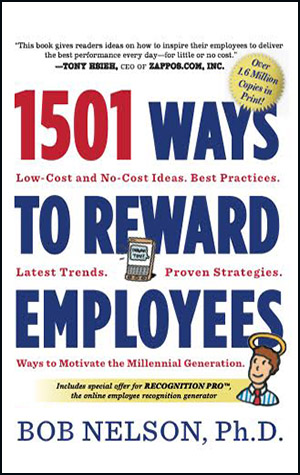
People are often motivated by reward systems. And reward systems are a crucial part of game mechanics. This is the reason I added this book to this category. Dr. Bob Nelson is a best-selling author who primarily writes about management and motivation.
And in 1501 Ways to Reward Employees, he goes over and beyond the garden variety rewards we’re all familiar with. Instead, Dr. Bob shares low- and no-cost rewards and strategies that he’s discovered from consulting and studying thousands of companies across the world.
More importantly, the book includes sections about how to reward the new workforce: virtual employees, freelancers, and international colleagues. A must-have for anyone in learning & development.
Reward yourself and get this book here.
Reality Is Broken: Why Games Make Us Better and How They Can Change the World by Jane McGonigal
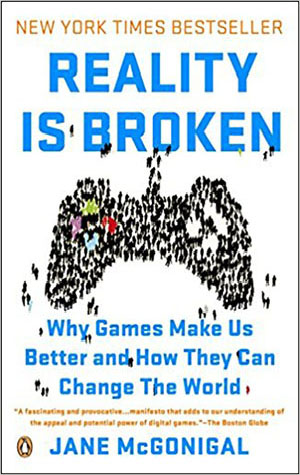
If you want to dip your metaphorical toes in the future of gamification, look no further than Reality is Broken. This book won’t only change the way you think about learning and development but will blow your mind with just how much potential gamification has on everything around us.
Game designer Jane McGonigal argues that we can harness the power of games to make the world better. Sounds like a pie in the sky statement? Hardly. McGonigal makes a persuasive case and offers an exceedingly smart analysis of the social implications.
She provides a useful framework for what makes great games great and shows how these principles can be applied to the world around us. You’ll be buzzing with ideas long after you put it down.
Other readers have said it’s, “Brilliant in vision”, “compelling”, and “powerful and provocative”.
Buy it from here.
Talent management books
Learning and development is one of the most important pillars of an organization’s talent management. With this in mind, any aspiring chief learning officers will more than likely want to have a holistic view of what works and what doesn’t work. These four talent management books offer an excellent foundation to help you do that.
Optimizing Talent (Contemporary Trends in Organization Development and Change) by Linda D. Sharky and Paul H. Eccher

As part of the L&D community, you already know that a good L&D strategy has the power to transform a business and its people.
In Optimizing Talent, Linda Sharky and Paul Eccher do an admirable job of presenting the facts, trends, and challenges as they are.
Backed up with reliable research, they talk about what kind of commitment it takes to succeeds, how the talent optimization process works, and what kind of results you can expect. All the way through, they deliver practical advice. This results in a text that is easy to understand and you can apply all you have learned immediately.
Complete with examples, tools, and models (The Talent Optimization Framework, in particular) they hand you all the knowledge you need to boost your talent.
Other readers have called it, “the keys to the kingdom”, “concise yet extremely powerful”, and “a pragmatic and research-based guide”.
Your L&D library will be incomplete without this book. Get it here.
The Toyota Engagement Equation: How to Understand and Implement Continuous Improvement Thinking in Any Organization by Tracy Richardson and Ernie Richardson

How did Toyota become one of the most efficient and most profitable automakers in history? By a simple strategy eventually coined the “Toyota Production System” (TPS). Instead of keeping it secret, Toyota shares and donates this system to partners and nonprofits around the world to help them grow and be more efficient too.
Toyota veterans Tracy and Ernie Richardson add to that legacy of sharing in their book The Toyota Engagement Equation. This is a behind-the-scenes look at how employees at Toyota were developed, how they were taught to spot and define problems through standardization, how they were coached to solve them, and how they were encouraged to improve their thinking.
A fascinating case study. Find it here.
Coaching to Win: A Proven System for Developing People and Driving Performance by Jane Pierce

Jane Pierce takes an unusual approach to a management book. She just tells a story. And it works.
Meet Sam. He’s a manager at an auto brand. And he’s facing one crisis after another, i.e., a staffing problem and conflicting priorities. As you follow him on his journey, you’ll learn to take an honest look at your leadership style and adjust your thinking. When this happens in the story, Sam wins over those around him.
In a few hundred pages, Pierce puts together a complete framework for seeing and nurturing the potential in others.
Other readers have called it, “mandatory reading for emerging leaders” and “one of the most valuable and impactful books on management I’ve ever read”.
Get it here.
Learning & business strategy books
There is often a struggle between training managers and the C-suite. Your goals are learner-centered, while the C-suite are looking out for the business. The truth is that these aren’t opposing goals, but inextricably linked. The books in this category will help you find a way to reach your learning objectives and business success.
The Six Disciplines of Breakthrough Learning: How to Turn Training and Development into Business Results by Roy V. H. Pollock, Andy Jefferson, Calhoun W. Wick

Training for the sake of training is not the smartest business strategy. Some might say it’s a fool’s errand. So, how do you make sure your training doesn’t only align with business needs but also shows business results?
Use the 6Ds! Seasoned learning professionals Pollock, Jefferson and Wick offer an easy-to-understand and implement strategy so you can get the best results from your L&D program.
You’ll learn:
– Specific strategies and actions that can be put into effect quickly for immediate results
– How to make a more precise connection between dollars spent and new skills gained
– How to audit new and existing training programs (Checklists included in each chapter)
Other readers have called it “a must-read”, “a game changer”, and “one of the best resources on integrating a culture of learning and development within your organization”.
Get it here.
The Field Guide to the 6Ds: How to Use the Six Disciplines to Transform Learning into Business Results by Roy V. H. Pollock, Andy Jefferson, Calhoun W. Wick

Yes, I’m putting another book by the same authors. In The Field Guide to the 6Ds, you’ll consolidate everything you learned in The Six Disciplines and get tons of practical info to put all that knowledge into action. Packed with tips, tools, advice, and checklists, it’s an invaluable companion.
I particularly enjoyed Part 3 where the authors present all the strategies through various case studies and show precisely how they did it.
Readers have called it, “most valuable resource I’ve owned in the 19 years of my career in learning, development, and Performance Improvement” and “the most pragmatic guidebook I have ever seen”.
You can find it here.
Transferring Learning to Behavior: Using the Four Levels to Improve Performance by Donald Kirkpatrick and James D. Kirkpatrick

This book deserves a place in your training shelf preferably alongside Kirkpatrick’s Four Levels of Training Evaluation.
This time father and son team up to shed practical information on how to implement the four levels. For the uninitiated, the Kirkpatrick training evaluation model is made up of four steps: The first is the reaction of your learners. Second, to what extent learning has been achieved. Three, how much behavior has changed and four, to what extent organizational performance results have been effective.
In this book, they shine a light on the last two particularly (behavior change and organizational results) with to-the-point principles, guidelines, ideas, and insights.
If the C-suite has ever asked you to prove the outcomes of your work, this is for you.
Other reviewers have said, “important book, rich with valuable content” and “will help any company maximize the results of its training program”.
Get it here.
Seven Trends in Corporate Training and Development: Strategies to Align Goals with Employee Needs by Ibraiz Tarique

Ibraiz Tarique knows HR. And according to his former students at Pace University, he also knows how to teach HR. Luckily, you don’t have to attend one of his lectures to get part of his wisdom.
In this book, Tarique presents seven trends that are changing workplace training, e.g., globalization, demographics and hybrid career paths. He offers clear guidance that any training managers can use to prepare.
You’ll learn:
– What future learning systems will look like
– How to use emerging technologies and new approaches to collaboration
– How to get more value from informal learning
– How to measure training ROI
Other readers have called it, “invaluable” and “insightful”.
You can buy it here.
Learning and Development Culture books
How do you build a learning culture in your organization? One way is to ensure you have the right managers in place to promote the values of learning always. The books in this category are for anyone leading a team or who wants to lead a team in the future.
Minds at Work: Managing for Success in the Knowledge Economy by David Gebrow and Stephen J. Gill
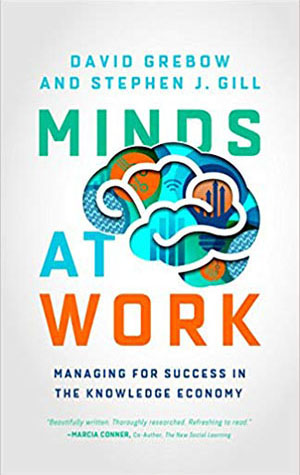
Back in the early days of work, in the Agricultural Economy, we managed backs. In the Industrial Age, we managed hands. Today, in the Knowledge Economy, we have to manage minds. And that’s an entirely different ballgame.
Long-established management practices aren’t particularly useful in this changing landscape. David Gebrow and Stephen Gill take this challenge head-on. And provide sound reasons for the importance of a continuous learning culture as well as strategies that will help you get there.
Readers have said its “excellent for genuine change in your organization!” , “a masterful modern case to put people at the center of every organization’s value chain” and “thoughtful and thought-provoking”.
Buy it here.
Managers As Mentors: Building Partnerships for Learning by Chip R. Bell
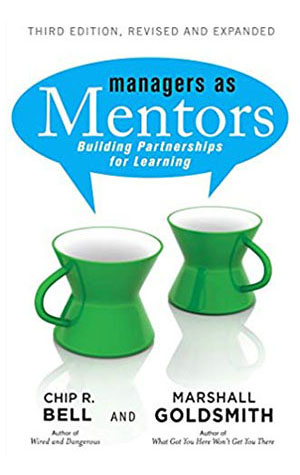
The 70-20-10 model of learning continues to make an impact. In this book, Bell focuses in on that 20%. The knowledge that employees get from interactions with others, specifically managers.
After a broad review of mentoring, Bell presents solid ideas grounded in research and proven to work. With interviews from six top U.S. CEOs like Joe Almeida of Covidien and Liz Smith of Bloomin’ Brands, Managers as Mentors doesn’t only offer up the what’s and why’s but the how-tos too.
Reviewers have called it, “Sold, practical, readable and actionable”, “a clear and practical guide for making learning an easy, everyday activity” and “the type of work that I will return to again and again”.
Find it here.
75 Ways for Managers to Hire, Develop, and Keep Great Employees by Paul Falcone
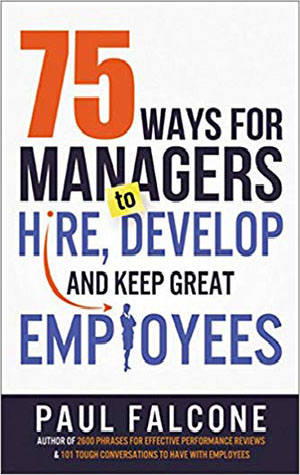
If you can only get one book to supplement your management training, this is it. Paul Falcone is essentially the Bruce Springsteen of the HR world. He’s not just a prolific writer and speaker, but his books are always highly practical.
75 Ways for Managers to Hire, Develop, and Keep Great Employees is one of those books. In this work, he casts his gaze on employee retention. Paul shares his best practices in the form of useful tools and specific examples that you can use straight away.
Readers have said, “[it’s] the ultimate desk reference for every manager”, “Every manager should have a copy of this book”, and “For those on the cusp of management, this book is unparalleled”.
Buy it from here.
Make Talent Your Business: How Exceptional Managers Develop People While Getting Results by Wendy Axelrod and Jeannie Coyle

We are what we do every day.
This is especially true when it comes to learning and development. An organization that wants to adopt the values of a learning culture can’t only offer training once a month and hope for the best.
So, what is particularly useful about Make Talent Your Business is that Wendy Axelrod and Jeannie Coyle show you a way to develop employees day-to-day. By studying exceptional development managers (EDMs), the authors offer five practices that can fundamentally change the way you think about managing and growing your people.
Other reviewers have said, “[it’s] accessible, readable and powerful”, “a true tour de force” and “the definitive guide for developing people in organizations”.
Find it here.
An Everyone Culture: Becoming a Deliberately Developmental Organization by Robert Kegan and Lisa Laskow Lahey
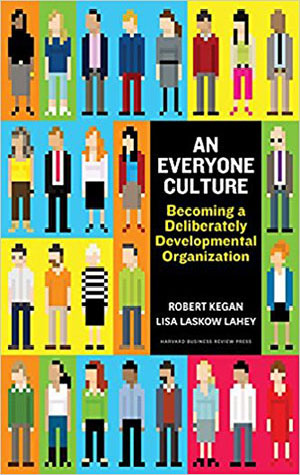
In this book, developmental psychologists Rob Kegan and Lisa Lahey attempt to answer one question: “What is the most powerful way to develop the capabilities of people at work?”
The simple answer: the deliberately developmental organization (DDO). What is a DDO? They’re organizations with a heavy focus on all workers’ personal-growth, company culture and transparency. In other words, these are organizations where development is daily and not a once-in-a-while event.
After reading it, you’ll know:
– The twelve common features of a DDO
– The business value of DDO
– 3 examples of a DDO
– How to start setting up your DDO
Other readers have said it’s “truly revolutionary”, “highly original”, and “will transform how you think about work”.
Get it here.
Interesting books that don’t fit into a category
These are books as the title suggests that didn’t fit any of the categories we created. But still offer unique advice that you might like to consider.
Bridging the Soft Skills Gap: How to Teach the Missing Basics to Todays Young Talent by Bruce Tulgan

Don’t be fooled by the title of this book.
While Bruce Tulgan focuses on teaching soft skills to today’s young talent, his book is actually a must-have for all employees. As part of the L&D world, you’re well aware of the expression, “People get hired because of their hard skills but get fired because of their soft skills”. You can also probably think of at least one instance where a team wasn’t functioning correctly only to discover the cause was one employee with poor communication skills.
In Bridging the Soft Skills Gap, Tulgan uses his twenty-year experience to recommend solutions to this problem. How? With ninety-two step-by-step lesson plans that are as flexible as they are easy to use.
Other readers have called it “a powerful tool”, “a valuable resource” and “a clear and concise book full of helpful strategies for managing younger workers…or even badly-behaved older ones”.
Get it here.
6-Hour Safety Culture: How to Sustainably Reduce Human Error and Risk, (and do what training alone can’t (possibly) do) by Tim Autrey

While we’re on the topic of specific training skills, this book by Tim Autrey on building a safety-first culture is so thought-provoking and actionable, you’ll want to add it to your list.
The fundamental question he raises is whether all employees will do the right thing when no one is watching.
Whether you’re responsible for safety training or not, you’ll still glean valuable information from The 6-Hour Safety Culture. With fascinating stories drawn from Autrey’s experiences within the US Naval submarine service and the nuclear power generation industry (where safety is paramount), you’re left with a blueprint for changing the organizational culture one person at a time.
Readers call it, “impactful”, “a superbly useful book” and “a sane, simple, sustainable approach and a breath of fresh air!”.
You can find it here.
Engaging the Online Learner: Activities and Resources for Creative Instruction by Rita Marie Conrad and J. Ana Donaldson

Engagement is often the alpha and omega of online training. Without an engaged learner, the best learning strategy in the world won’t succeed. If you need an introduction to the topic of engagement, this is it.
Rita Marie Conrad and J.Ana Donaldson provide some excellent ideas and resources for you to use in your online training, as well as a framework so you can understand why engagement is so meaningful.
Readers have called it, “an encyclopedia of tried-and-true learner engagement activities that are authentic and ready to use”, “an invaluable guide” and “A great place to start your journey”.
Get it here.
Help Them Grow or Watch Them Go: Career Conversations Employees Want by Beverly Kaye and Julie Winkle Giulioni
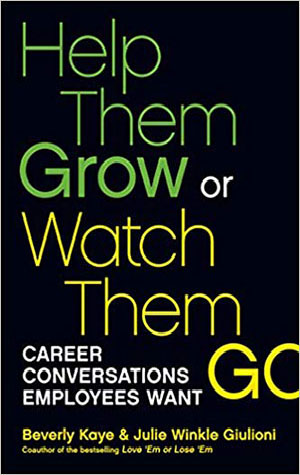
While this book clocks in at just 144 pages, it’s big on advice. It’s also an essential companion to any trainer who is tasked with training managers to be better managers.
Beverly Kaye and Julie Winkle Giulioni get right down to the crux of the matter: conversations. Often, in the quest to retain employees and boost productivity, companies create complex systems. Kaye and Giulioni simplify it.
Filled with practical tips, guidelines, and nearly a hundred questions to use in your conversations, this little book will change the way you think about career development in your organization.
Buy it here.
Employee Development on a Shoestring by Halelly Azulay

We all know the 70/20/10 model of learning and development. For the uninitiated, this model comes from research that suggests learners at work get 70 percent of their knowledge from job-related experiences, 20 percent from interactions with others, and 10 percent from formal educational programs.
In Employee Development on a Shoestring, Azulay shows you the way to optimize that 70% of on-the-job training so that your learners can continue to grow in the right direction – and how you can do it on a budget.
You’ll get useful things like:
– Templates, worksheets, checklists, and guidelines for effective development
– How to turn development into fun games and contests
– How to let employees turn stories from the frontlines into digital content for everyone’s benefit
Reviewers say it’s “superb resource for growing talent in any industry and any organization”, “terrifically researched guide”, and has “easy-to-implement ideas”.
Get it from here.
Disclaimer: All cover images in this post are used for review purposes only. All cover images rights belong to the respective owners.



